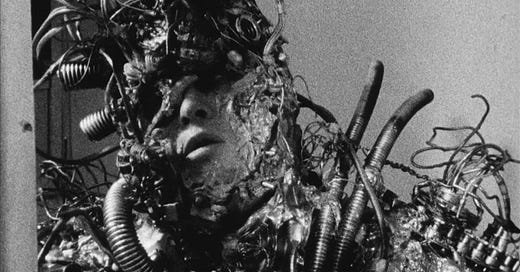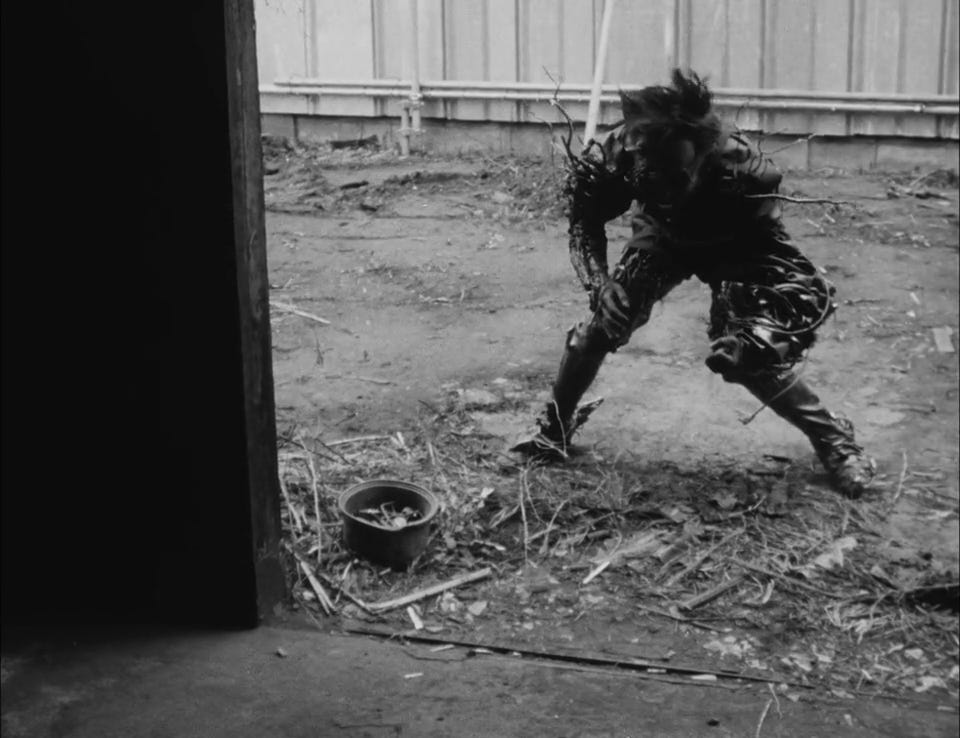Shinya Tsukamoto was at a crossroads in 1988. Having just graduated university and about to enter the workforce, his father denounced his artistic dreams as a failure and told him to devote his life to being a salaryman.
Tsukamoto continued to make movies by night though, using the money he earned from his dayjob. Tetsuo: The Iron Man was filmed in his apartment over a year and a half. Money was tight. Tsukamoto had to get creative with the practical effects, salvaging old scrapyards and factories for props and materials. They ran out of money halfway through filming, and everyone but the actors left. Tsukamoto was so frustrated he contemplated destroying the film.
When it was released, Tetsuo was entered into the Italian Fantafestival, where it screened without subtitles (Tsukamoto couldn’t afford to add any). To his surprise, it won first place. Tsukamoto had proved his father wrong.
You can see some of these anxieties in Tetsuo. A surrealist horror movie, it follows a salaryman who is tormented by a “metal fetishist”. The fetishist is transforming people into metal - or the metal itself is taking over people, joining everyone and everything into a single entity that will encompass the whole universe.
The movie was shot on 16mm film in black and white, which cleverly accentuates the differing greys and silvers of all the metal. The composition of shots is dark and cramped; you get the sense that danger could be lurking just off screen. When the salaryman is chased by a woman with a metal hand, he scrambles through subway corridors swathed in shadow. Later, as the salaryman turns into the iron man, he scurries away from his girlfriend into the dark corners of their apartment, like a rat or insect avoiding the light.
When these characters transform into monsters, they protrude wires, springs, pipes, and cogs in live-action stop-motion. These costumes, made by gluing and taping broken TV parts, wires, pipes, and foil to the actors’ skin, are absolutely gorgeous to look at.
The monsters jerk about like spiders in sped-up shots. They hunch over in shadows, where you can’t really see them. When they attack, frenetic jump-shots make it hard for us to tell where they actually are in the room. And when you think you understand what the monster is, it mutates again. Even within a scene - where you expect each shot to be logically connected - the action suddenly speeds up or slows down. Some scenes are rewound and played again. The confusion gives your mind no purchase.
Just when you’ve adjusted to a high-speed stop-motion chase scene (a clever, no-budget way of showing two monsters with rockets on their feet zooming across the city), time suddenly slows down again. The monster, standing slightly too far away in a shot too dim to make out what’s happening, stutters into the light in an unpredictable, inhuman way.
As the monster lurches forward, the lighting is just right to pick up the shine of its eyeballs, and your instincts fire - the same ones which warn you about flashing things in the night. It’s like doing a pukana in the mirror. It looks scary because you can’t quite see what’s going on, and your brain isn’t able to fill in what’s missing with anything sensible.
These are the ingredients of a well-crafted horror. While Tetsuo was obviously filmed on a very low budget, the creative use of practical effects make for pretty convincing and utterly unique monsters - though sometimes, in brightly-lit outdoor scenes, they are a bit more tinny than scary.
So what is this movie actually about? Well… you can read the summary on Wikipedia. The story is not told directly. There is almost no dialogue and only a handful of characters. In this regard Tetsuo presents itself almost like a silent movie.
What you learn, you find out through simple juxtaposition. As the woman with the metal hand chases the salaryman, we see another man laughing from behind a strange console. Clearly, he is responsible for this. The back of his head drips with blood. Later, we watch a video on a TV set in which a doctor explains - almost directly to the viewer - that he has a metal pipe lodged in his brain. In what must be a flashback, we see him being bludgeoned with the pipe as a child.
This strange man/machine is the fetishist. After being hit by the salaryman’s car, he is back for revenge. Both men turn into strange metal monsters. As they battle with each other, they witness an apocalpytic vision: the entire universe as a single, decaying, metallic entity. They merge into one being and proceed to remake the world in this image.
Tetsuo could be read as the anxieties of a hyper-connected, technological, industrial world. In technology’s narcotic rush to expand and encompass all aspects of our life, old norms are thrown aside, and our individualities erased. The characters’ bodies are augmented, morphed, and deformed. Some choose this; others do not. Their humanities are overwritten in ways that are not quite explicable, which is terrifying, but also thrilling: now there is the possibility of doing things that were once impossible, because the moral inhibitions have been swept away, and the physical limitations overcome.
So the women who chases the salaryman at last takes off her glasses, realising she has no need for them. When the fetishist finally reveals himself, he is dressed like the cut-out pictures of sports stars we see around his apartment. They are the peak of the human body - and he is its next stage.
The posthuman form is both grotesque and beautiful. It is capable of unifying all forms of pain and pleasure, best shown in the opening scene in which the salaryman writhes in pain like he is being seized up by tetanus. If you only saw his movements, you would think he is dying. But with the thumping, rape-and-pillage industrial music playing, his agonies come to us as a kind of death dance, a slow acceptance - and mastery - of pain.
This is my favourite scene in the movie. It has absolutely nothing to do with the story and is never brought up again, but it seems to me to encapsulate everything the movie is about.
(If, like me, you’re a wimp regarding horror, know that the below video is not really scary, just weird).
And sex. The movie is filled with weird sex. Lust overwhelms the characters, but their release is never satisfying, and they are always hurting one another.
The salaryman and his girlfriend hit the fetishist with their car and hump against a tree while someone (the dying fetishist?) watches. The salaryman has a dream in which his girlfriend has a hose-like penis, and rapes him with it. In real life, they have sex in their apartment in such a contorted position you wonder if her spine isn’t going to break. And when he turns into the iron man, she is initially terrified, before being overcome with lust, at which point they have sex, and he kills her with his penis, now a massive drill.
These characters have sex like wild animals rape each other. Those same biological urges are also what compel the salaryman and fetishist to merge together, which happens in a sexual act. Even when they are no longer human, something of their nature and urges remain - but as perversions of what we recognise as human. Their motives, like their mutated bodies, seem human, but are deformed beyond all recognition. Yet there is still something animal and therefore biological about them; in the fetishist’s vision of the entire universe connected and transformed through metal, a skull decomposes into metal wires in a montage that resembles mould breaking down an apple.
By splicing all kinds of filmic genres together, Tetsuo is filmed in a way which reflects this unity of new possibilities. Bits of the movie are like music videos. Some scenes are live action, others stop motion. There is shaky hand-cam footage. Some scenes are watched on a screen. Parts of the movie are sped up or slowed down, hazy with static or blurred with pixels, rewound and replayed. A doctor narrates the fetishist’s story almost directly to us, breaking the fourth wall. The fights between the monsters are like a cross between anime and kaijū (think Japanese monster movie e.g. Godzilla).
The movie also has some bizarre humour in it. The final fight ends with the salaryman and the fetishist making love, shown by them nakedly floating towards each other in their human forms, looking like unborn children, while cheesy jazz music plays over the top. This strange choice of music also plays as the iron man screws (literally) his girlfriend to death with his drill penis.
I don’t really know what to make of these scenes. I guess Tsukamoto has a perverse sense of humour. They also thankfully walk the movie back from the edge of outright pornography.
Tetsuo is a weird movie. At its heart are numerous contradictions. Pain and pleasure are singularly expressed in the grotesqueries of the posthuman body. Humour and action and horror mingle freely.
Sometimes the movie careens too fast between these extremes, going from kitsch to horror and back, via the uncanny valley. This makes it seem like both reality and cartoon, and occasionally tests your ability to suspend disbelief.
And the pacing is very uneven - intentionally so, yes, but the middle section of this movie drags. While only an hour long, Tetsuo feels twice that.
It really is strangely alluring though, a nightmarish mix of theatre, horror, music video, and silent film. Tsukamoto had to re-invent filmic story-telling because of his low budget. That’s what’s most fascinating: just how differently a story can be told when its conventions have to be thrown out and re-made - which is also what this movie is about: the redefinition of human nature.
The metal costumes, eerie stop-motion, decaying metal, thumping soundtrack… Tetsuo is uncomprisingly strange. I wouldn’t want it any other way.






